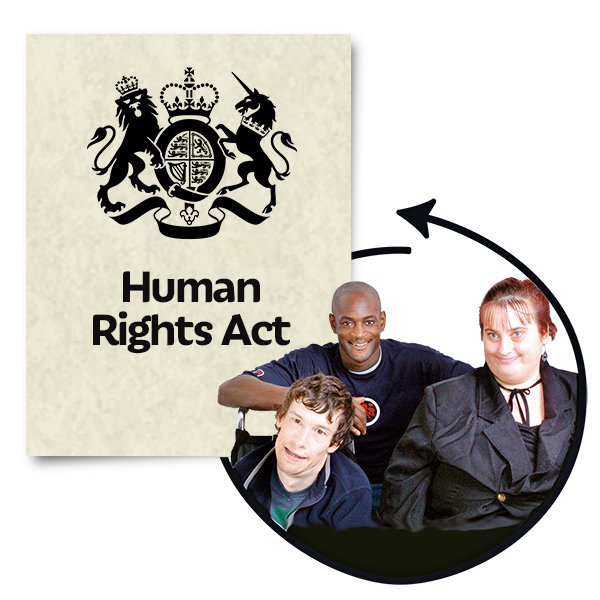Vulnerable and alone, many individuals are kept in inpatient units miles from home. Here, they are at increased risk of abuse and neglect, in environments that don't meet their needs and can lead to lasting trauma.
In the first six months of this year, there were nearly 26,000 reported uses of restrictive practices in England, such as people being kept in isolation or being restrained – either physically or with medication.
In some instances, mechanical restraint was used. Despite fighting for years to get their loved ones out, families like Alison and Adam often feel powerless against the system. This is a
human rights
 Human
rights
Human
rights
 Rights are the things everyone should be allowed to do like have a say, or go to school.
are the rights that everyone has. These include the right to go to school and the right to start a family.
scandal.
Rights are the things everyone should be allowed to do like have a say, or go to school.
are the rights that everyone has. These include the right to go to school and the right to start a family.
scandal.
People with a
learning disability
 A learning disability is to do with the way someone's brain works. It makes it harder for someone to learn, understand or do things.
should be able to live in a home surrounded by people who love and care for them, with the right support in their
community
A learning disability is to do with the way someone's brain works. It makes it harder for someone to learn, understand or do things.
should be able to live in a home surrounded by people who love and care for them, with the right support in their
community
 A community is the people and places in an area.
so they can live happy and healthy lives.
A community is the people and places in an area.
so they can live happy and healthy lives.
With your support, we can make sure things change to stop people being treated like Adam ever again.
A happy childhood in the neighbourhood
Adam was a boisterous little boy, the second youngest of my six children. He loved to ride his bike through the park and would curl up on the sofa in front of the TV in the evenings, watching ‘The Bill’ with me. He was so happy in our neighbourhood and would often offer to wash people’s cars, earning a pound for each one he cleaned. He got on so well with the neighbours and cleaned up!
At the age of five, Adam struggled to speak. I could see that he found it hard to retain information and to read and write. This led to a diagnosis of
autism
 Autism is a disability. Autistic people find it difficult to understand what other people think and feel. They also find it difficult to tell people what they think and feel. Everyone with autism is different.
when he was eight, but his learning disability went undiagnosed until he was 15.
Autism is a disability. Autistic people find it difficult to understand what other people think and feel. They also find it difficult to tell people what they think and feel. Everyone with autism is different.
when he was eight, but his learning disability went undiagnosed until he was 15.
Throughout primary school, Adam attended speech and language therapy in the mornings and went to a mainstream school in the afternoons. When he reached secondary school age, it was decided that it was in Adam’s best interests for teachers to visit him at home for one-to-one lessons. Adam found Maths and English difficult, but enjoyed his weekly drum lessons and outings to a nearby outdoor activity centre.
Adam’s troubled teenage years
Adam was desperate to fit in at school, but by the time he was a teenager he was being bullied by a group of local teens who took advantage of his naivety. He would do whatever they told him to do without understanding the danger it could get him in. It was all for their own entertainment, but Adam had no clue about that. Adam couldn’t understand how other people thought or behaved. He was taken advantage of so many times.
After years of issues and failures to get clarity about his learning disability, Adam went missing for four days. He was only 13. I was distraught and even contacted the local radio station to help find him. When the police eventually tracked Adam down, he was with a group of tearaways who had led him astray.
Social services got involved and removed Adam from my care, placing him in a children’s home. I was shocked and devastated, but made sure I visited him every evening.
The beginning of hospital admissions
Two years later, in 2007, Adam was placed in a medium-secure psychiatric hospital for adolescents. He was 15.
Adam’s stay was supposed to be temporary for
assessment
 An assessment is a way of finding out what help a person needs. When you have an assessment, you might have to go to a meeting or fill in a form.
purposes, but while he was there his behaviour deteriorated. Adam had no idea why he was in the unit. He lashed out in frustration, ruling out any chance of discharge.
An assessment is a way of finding out what help a person needs. When you have an assessment, you might have to go to a meeting or fill in a form.
purposes, but while he was there his behaviour deteriorated. Adam had no idea why he was in the unit. He lashed out in frustration, ruling out any chance of discharge.
Years passed despite me pleading for help to get Adam out of there. My son was moved between various institutions, and I could see he was visibly frightened and distressed. Adam was often covered in bruises and on occasion he would zone out from antipsychotics and anti-epileptic medication, even though he had neither psychosis nor epilepsy.
Adam would beg me to get him out of there, and as a mother you will do anything for your child.
I’ve kept on battling for Adam’s release.
Inhumane hospital treatment
At the beginning of 2021, I thought things were turning a corner for Adam. He was in a medium-security unit at a local centre. Adam enjoyed several successful days out with carers, visiting family and going shopping. His carers observed how much better he was when he was off the ward.
But back on the ward, Adam was assaulted by a fellow patient and retaliated. He was punished with five weeks of seclusion, during which he was forced to defecate in a bowl passed through a hatch. This was the same hatch through which he received food, and staff failed to collect the bottles into which he urinated.
Most people would agree that this type of treatment is barbaric for anyone, let alone a vulnerable person.
Locked up with dangerous criminals
Later in 2021, Adam was sent to one of Britain’s top security psychiatric hospitals. In-patients include convicted serial killers. I pleaded with the
social worker
 A social worker is someone who can help you get the support you need. Social workers usually work for your local council.
to stop this move. I was told that Adam had to go there because the local centre couldn’t manage him. Once again, the system had failed my son.
A social worker is someone who can help you get the support you need. Social workers usually work for your local council.
to stop this move. I was told that Adam had to go there because the local centre couldn’t manage him. Once again, the system had failed my son.
It looks like a prison, with rooms with little windows like cells.
Adam has to share a ward with forensic patients (sectioned for criminal offences) when eating and watching television. He’s often locked up alone in a bare room with nothing but a mattress because of minor or trivial ‘misunderstandings’.
Mealtimes is just one example. Menus are put out three days in advance and in-patients need to write what they want to eat, but Adam can't read or write. Staff didn't help my son because they didn't even know that about him. Adam randomly ticked the form. Then, when the meal came, he got anxious saying: “I don't want to eat that”. He argued with staff and ended up in seclusion, with no fresh air and communication taking place through a locked door. One time, Adam was restrained and kept overnight in seclusion with a broken hand.
It’s hard to see him, because the hospital is so far away in the middle of nowhere. When I can visit, Adam is withdrawn and has stopped smiling.
I can’t even ring Adam and, when I can see him, there are always staff sat with us. It takes a big toll on you having to go to a high-security hospital like that.
When I visited Adam one Sunday, I saw a large, red warning sign at the entrance to the ward. It read: ‘You are going through this door at your own risk’. I love to see my son, but it's hard when he’s in a place like that where he shouldn't be. When Adam turned 30 in May, he celebrated his milestone birthday alone in an institution. It’s so upsetting when my son should be living his life.
Adam has to share a ward with forensic patients (sectioned for criminal offences) when eating and watching television.
I’m determined that Adam’s freedom will be the next chapter in his life, and the stories that follow will be of happier times for my son and our family.
By giving today, you could help end this human rights scandal and continue to support families until their loved ones are released. You could help people like Adam to be back home in their community where they belong, living fulfilling lives close to their families and friends, with proper support in place.

 By Mencap
By Mencap